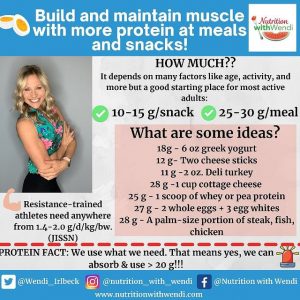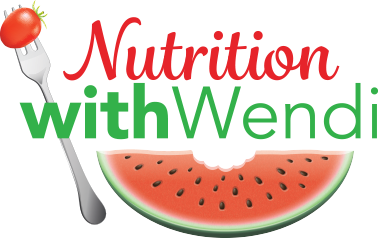
Avoid making these common mistakes when trying to lose fat and gain lean muscle mass! (VIDEO ON FAT LOSS MISTAKES)
1. Skipping meals
Many people think they are doing the right thing by skipping breakfast and avoiding eating until they are ravenous. Skipping meals will lead to an imbalance in blood sugar levels (1). Skipping meals will also lead to overeating at the next meal but it’s not sustainable nor is it optimal for maintaining lean mass. We know lean mass helps burn more fat. Our blood glucose levels drive our energy, focus, concentration, and productivity to name a few (1). Focus on powering up with protein and produce at breakfast. Protein will help keep you satisfied and help regulate your hormones that control hunger.
2. Eliminating entire food groups and fad dieting
People go rouge and cut out entire food groups. Eliminating food groups is not a wise choice and is often a mistake I see many falling victims to as a dietitian. People vilify or demonize carbohydrates because of their sugar content. The reality is that successful fat loss comes down to a calorie deficit. You can most certainly eat fruit and still lose fat. Don’t listen to the misinformation from clowns demonizing fruit or even carbohydrates. Research supports carbohydrates as a critical part of a healthy diet as well as supporting weight loss goals (2). Carbohydrates provide our muscles and brain with energy. If you’re hoping to lose fat and crank up the intensity in the gym but decide to cut out fruit and carbohydrates, you’ll likely experience fatigue quickly. You don’t need to cut carbs or eliminate fruit to lose fat (3). Nutrition with Wendi fat loss clients does not cut carbs or eliminate food groups. If you’re interested in learning how to portion your carbs and a macronutrient breakdown, please contact me by booking a consultation.
3. Cutting calories too low or underestimating portions
Cutting calories too low too quickly will not only leave you feeling tired, depleted, cranky, and full of cravings it will also put you at risk for nutrient deficiencies. It’s also unsustainable to live off poverty macros in the 600-900 kcal range. No one should be going below 1200 calories per day. It is too low, not sustainable, and will put you at risk for unhealthy habits and a host of other consequences. One thing I teach my clients and athletes is that our methods and systems when working towards any goal must be sustainable or our results won’t be. Sure, you could slash your calories for a few weeks and lose a few pounds, but it will come back with a vengeance if you can’t keep it up. It is best to start off with a daily 200-300 kcal deficit which followed consistently will help you lose 1-2 lbs. per week and keep it off. Keep it off for good when done properly. 95% of people regain the weight they lose. See a great resource on how to build a plate here and consult with a dietitian to determine your individual calorie needs.
Studies suggest that people tend to misreport and incorrectly estimate how many calories they consume (4). Many think they are eating in a calorie deficit when indeed they are not eating in a calorie deficit. All Nutrition with Wendi fat loss clients record their intake and track their portions to facilitate self-awareness of calories and portions. You can’t manage what you don’t measure.
For example, a person may report they are consuming one serving of almonds per day may but are actually consuming 2.5 servings unknowingly. This is often due to grabbing a handful between meals or throughout the day without any concept of true portion size. Handfuls and bites can add up quickly putting a person in a calorie surplus each day without even knowing it and then “expressing their efforts are wasted”. This is a simple correction of both a mindset and accurate tracking by learning serving size to support an honest leger of calories consumed.
Higher calorie foods like nut butter are important to measure out to you’re aware of the portion size. It is not obsessive to track your intake if you have a goal to lose weight. For example, if you and your family are planning on taking a vacation to Disney World you don’t just guess how much money you should save each month and eyeball your savings adding some money here and there from a paycheck or two and cross your fingers for the best. No, that would be reckless and not leave many of us with the funds to take a trip to Disney World with the family because we had no concept of a budget. To achieve your vacation fund needs you would identify a budget and allocate your funds accordingly by the week or month to ensure you have hit a designated fiscal goal. This is the same for our fat loss goals. Tracking and managing our intake is critical to be aware of what we are “eating” just like how much we are spending. If you’re not aware of your finances, you are likely to go into debt or be limited with your vacation or retirement options.
4. Not enough resistance training
When people want to lose weight, they quickly default to more cardiovascular exercise like running or more time on the elliptical. While increasing your cardiovascular exercise is good for heart health, stress management, and reducing the risk of chronic disease it is not the best form of exercise for fat loss. I’m not saying cardio can’t help but it is not as optimal as resistance training. Additionally, people often overestimate how many calories they burn during cardio, and it also does not offer the same muscle-building benefits as resistance training does. Cardio won’t help you lose fat and chisel your body in the way you desire. You need to lift weights. Resistance training burns more calories at rest and supports gaining lean mass which burns more fat at rest. This is referred to as (EPOC), which is the amount of oxygen required to return to its pre-exercise or resting state called post-exercise oxygen consumption. Read more about how resistance training helps raise resting metabolic rate in women in this 2018 study published in the International Journal of Exercise. Furthermore, having more muscle means a lower risk for sarcopenia. I have transformed my physique along with hundreds of others by prescribing four to five 20-30 min resistance training sessions per week paired. Strength training paired with daily walking and proper nutrition can lead to great results if consistently executed. Daily walking is a great way to manage stress, support digestion, mental health, and more. For fat loss resistance training is the best form of exercise (5). The more cardio you do also the hungrier you may feel which can lead to overeating which won’t help you sustain a calorie deficit to lose fat. Not to mention all the added load and stress on your joints and tissues become quite taxing and unsustainable. If your methods to losing fat aren’t sustainable your results won’t be. Research recommends combining both aerobic exercise and weight training for optimal results.
 5. Not eating enough protein
5. Not eating enough protein
Too many are skimping on their protein which is leaving them chronically hungry and unable to ever satisfy themselves (7). There’s also a great deal of misinformation that if we eat more than 20 g of protein in a meal it will be stored as fat. This is not true and has been dispelled in a position paper published in the (JISSN), Journal of the International Society of Sports Nutrition. We use what we need and for many that is more than 20 g at a time. Optimal protein intake should be broken down between meals and snacks to best support satiety, muscle growth, and muscle maintenance. For more read the JISSN Position Stand Paper featuring diets and body composition. A great way to enhance satiety and consistently eat in a calorie deficit is to increase protein intake at meals and snacks. Ideally, a good place to start would be at least 25g to 40 g of protein at a meal, along with 10 g to 15 g of protein at snacks. I have several resources on how to increase your protein with specific guides on my Instagram, Twitter, and blogs. For more on this see my previous blog on consuming greater protein for fat loss.
If you want to lose fat and gain lean mass you must be willing to reduce your calories appropriately, eat sufficient protein, be consistent with resistance training, sleep 7 to 9 hours, consume fluids and focus on quality movement or quantity. As a reminder, if your methods aren’t sustainable your results won’t be. What is measured is well managed are both important concepts that must be at the forefront when making changes to your nutrition, sleep, workouts, and more. Manage your calories like you would manage your finances if you’re climbing out of debt. Keep in mind that improving by one percent each day can add up over time. Compound your good habits and be consistently aware of what you are eating and how much of it you are eating. If you need help creating a plan to support your fat loss goals, please schedule a consult, or sign up for nutrition coaching! We will get you where you want to be without making the mistakes listed above.
In good health and many blessings,
Wendi Irlbeck, MS, RDN, LDN, CISSN
 Wendi Irlbeck, MS, RDN, LDN, CISSN is a registered dietitian nutritionist, healthy lifestyle coach, former college athlete, physique competitor, and avid weight lifter. Wendi utilizes evidence-based science to tailor nutrition programs for athletes to optimize performance, minimize health risks, and enhance recovery from training while focusing on injury prevention. She partners with parents, sports performance staff, and special needs and recreational athletes to offer nutritional guidance and optimal athletic performance and lifestyle plans. Wendi provides telehealth and on-site services. Wendi works with clients of all levels and ages across the US as well as Canada and the UK.
Wendi Irlbeck, MS, RDN, LDN, CISSN is a registered dietitian nutritionist, healthy lifestyle coach, former college athlete, physique competitor, and avid weight lifter. Wendi utilizes evidence-based science to tailor nutrition programs for athletes to optimize performance, minimize health risks, and enhance recovery from training while focusing on injury prevention. She partners with parents, sports performance staff, and special needs and recreational athletes to offer nutritional guidance and optimal athletic performance and lifestyle plans. Wendi provides telehealth and on-site services. Wendi works with clients of all levels and ages across the US as well as Canada and the UK.
Citations
-
Nas, A., Mirza, N., Hägele, F., Kahlhöfer, J., Keller, J., Rising, R., Kufer, T. A., & Bosy-Westphal, A. (2017). Impact of breakfast skipping compared with dinner skipping on the regulation of energy balance and metabolic risk. The American journal of clinical nutrition, 105(6), 1351–1361. https://doi.org/10.3945/ajcn.116.151332
-
Astrup, A., & Hjorth, M. F. (2017). Low-Fat or Low Carb for Weight Loss? It Depends on Your Glucose Metabolism. EBioMedicine, 22, 20–21. https://doi.org/10.1016/j.ebiom.2017.07.001
-
Hall, K. D., & Kahan, S. (2018). Maintenance of Lost Weight and Long-Term Management of Obesity. The Medical clinics of North America, 102(1), 183–197. https://doi.org/10.1016/j.mcna.2017.08.012
-
Brown, R. E., Canning, K. L., Fung, M., Jiandani, D., Riddell, M. C., Macpherson, A. K., & Kuk, J. L. (2016). Calorie Estimation in Adults Differing in Body Weight Class and Weight Loss Status. Medicine and science in sports and exercise, 48(3), 521–526. https://doi.org/10.1249/MSS.0000000000000796
-
Aristizabal, J. C., Freidenreich, D. J., Volk, B. M., Kupchak, B. R., Saenz, C., Maresh, C. M., Kraemer, W. J., & Volek, J. S. (2015). Effect of resistance training on resting metabolic rate and its estimation by a dual-energy X-ray absorptiometry metabolic map. European journal of clinical nutrition, 69(7), 831–836. https://doi.org/10.1038/ejcn.2014.216
-
Brown, R. E., Canning, K. L., Fung, M., Jiandani, D., Riddell, M. C., Macpherson, A. K., & Kuk, J. L. (2016). Calorie Estimation in Adults Differing in Body Weight Class and Weight Loss Status. Medicine and science in sports and exercise, 48(3), 521–526. https://doi.org/10.1249/MSS.0000000000000796
-
Antonio, J., Candow, D. G., Forbes, S. C., Ormsbee, M. J., Saracino, P. G., & Roberts, J. (2020). Effects of Dietary Protein on Body Composition in Exercising Individuals. Nutrients, 12(6), 1890. https://doi.org/10.3390/nu12061890
